Evaluating the Performance of Multiple Precipitation Datasets over the Transboundary Ili River Basin Between China and Kazakhstan
Abstract
1. Introduction
2. Study Area

3. Data and Methods
3.1. Data
3.2. Methods
4. Results and Discussion
4.1. Spatiotemporal Characteristics of Observed Precipitation
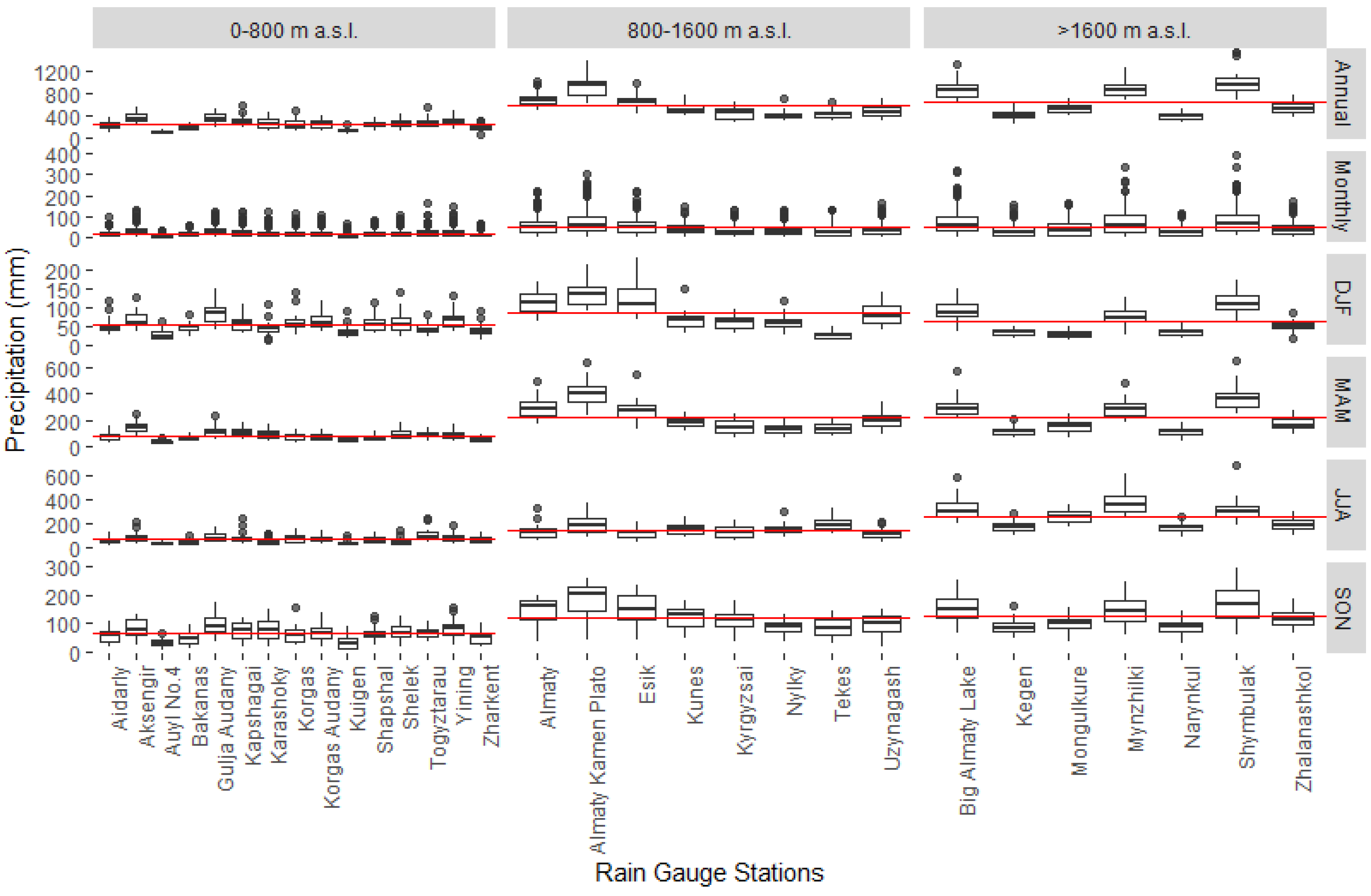
4.2. Point-Based Evaluation
4.2.1. Long-Term Monthly Mean and Anomaly
4.2.2. Basin Scale Performance
4.2.3. Elevation-Dependent Performance
4.2.4. Cumulative Distribution Analysis of Annual Precipitation
4.3. Basin-Wide Gridded Evaluation
4.4. The Role of Accurate Precipitation Data for Sustainable Water Management Under Climate Stress
5. Conclusions
Author Contributions
Funding
Institutional Review Board Statement
Informed Consent Statement
Data Availability Statement
Acknowledgments
Conflicts of Interest
References
- Yapiyev, V.; Sagintayev, Z.; Inglezakis, V.J.; Samarkhanov, K.; Verhoef, A. Essentials of Endorheic Basins and Lakes: A Review in the Context of Current and Future Water Resource Management and Mitigation Activities in Central Asia. Water 2017, 9, 798. [Google Scholar] [CrossRef]
- Beck, H.E.; Van Dijk, A.I.; Levizzani, V.; Schellekens, J.; Miralles, D.G.; Martens, B.; De Roo, A. MSWEP: 3-hourly 0.25 global gridded precipitation (1979–2015) by merging gauge, satellite, and reanalysis data. Hydrol. Earth Syst. Sci. 2017, 21, 589–615. [Google Scholar] [CrossRef]
- Funk, C.; Peterson, P.; Landsfeld, M.; Pedreros, D.; Verdin, J.; Shukla, S.; Husak, G.; Rowland, J.; Harrison, L.; Hoell, A.; et al. The climate hazards infrared precipitation with stations—A new environmental record for monitoring extremes. Sci. Data 2015, 2, 150066. [Google Scholar] [CrossRef]
- Peña-Guerrero, M.D.; Umirbekov, A.; Tarasova, L.; Müller, D. Comparing the performance of high-resolution global precipitation products across topographic and climatic gradients of Central Asia. Int. J. Clim. 2022, 42, 5554–5569. [Google Scholar] [CrossRef]
- Peng, J.; Liu, T.; Huang, Y.; Ling, Y.; Li, Z.; Bao, A.; Chen, X.; Kurban, A.; De Maeyer, P. Satellite-based precipitation datasets evaluation using gauge observation and hydrological modeling in a typical arid land watershed of Central Asia. Remote Sens. 2021, 13, 221. [Google Scholar] [CrossRef]
- Zandler, H.; Haag, I.; Samimi, C. Evaluation needs and temporal performance differences of gridded precipitation products in peripheral mountain regions. Sci. Rep. 2019, 9, 15118. [Google Scholar] [CrossRef]
- Muñoz-Sabater, J.; Dutra, E.; Agustí-Panareda, A.; Albergel, C.; Arduini, G.; Balsamo, G.; Boussetta, S.; Choulga, M.; Harrigan, S.; Hersbach, H.; et al. ERA5-Land: A state-of-the-art global reanalysis dataset for land applications. Earth Syst. Sci. Data 2021, 13, 4349–4383. [Google Scholar] [CrossRef]
- Hersbach, H.; Bell, B.; Berrisford, P.; Hirahara, S.; Horányi, A.; Muñoz-Sabater, J.; Nicolas, J.; Peubey, C.; Radu, R.; Schepers, D.; et al. The ERA5 global reanalysis. Q. J. R. Meteorol. Soc. 2020, 146, 1999–2049. [Google Scholar] [CrossRef]
- Beck, H.E.; Van Dijk, A.I.; Larraondo, P.R.; McVicar, T.R.; Pan, M.; Dutra, E.; Miralles, D.G. MSWX: Global 3-Hourly 0.1° Bias-Corrected Meteorological Data Including Near-Real-Time Updates and Forecast Ensembles. Bull. Am. Meteorol. Soc. 2022, 103, E710–E732. [Google Scholar] [CrossRef]
- Schneider, U.; Becker, A.; Finger, P.; Meyer-Christoffer, A.; Ziese, M.; Rudolf, B. GPCC’s new land surface precipitation climatology based on quality-controlled in situ data and its role in quantifying the global water cycle. Theor. Appl. Clim. 2014, 115, 15–40. [Google Scholar] [CrossRef]
- Sun, Q.; Miao, C.; Duan, Q.; Ashouri, H.; Sorooshian, S.; Hsu, K.-L. A review of global precipitation data sets: Data sources, estimation, and intercomparisons. Rev. Geophys. 2018, 56, 79–107. [Google Scholar] [CrossRef]
- Schneider, D.P.; Deser, C.; Fasullo, J.; Trenberth, K.E. Climate data guide spurs discovery and understanding. Eos Trans. Am. Geophys. Union 2013, 94, 121–122. [Google Scholar] [CrossRef]
- Huffman, G.J.; Bolvin, D.T.; Braithwaite, D.; Hsu, K.L.; Joyce, R.; Kidd, C.; Hsu, K.; Kelley, O.A.; Nguyen, P.; Sorooshian, S.; et al. NASA Global Precipitation Measurement (GPM) Integrated Multi-Satellite Retrievals for GPM (IMERG) Version 07. In Algorithm Theoretica Basis Documen; National Aeronautics and Space Administration (NASA): Houston, TX, USA, 2023. [Google Scholar]
- Tang, G.; Clark, M.P.; Papalexiou, S.M.; Ma, Z.; Hong, Y. Have satellite precipitation products improved over last two decades? A comprehensive comparison of GPM IMERG with nine satellite and reanalysis datasets. Remote Sens. Environ. 2020, 240, 111697. [Google Scholar] [CrossRef]
- Pradhan, R.K.; Markonis, Y.; Godoy, M.R.; Villalba-Pradas, A.; Andreadis, K.M.; Nikolopoulos, E.I.; Papalexiou, S.M.; Rahim, A.; Tapiador, F.J.; Hanel, M. Review of GPM IMERG performance: A global perspective. Remote Sens. Environ. 2022, 268, 112754. [Google Scholar] [CrossRef]
- Mahmoud, M.T.; Mohammed, S.A.; Hamouda, M.A.; Mohamed, M.M. Impact of topography and rainfall intensity on the accuracy of imerg precipitation estimates in an arid region. Remote Sens. 2020, 13, 13. [Google Scholar] [CrossRef]
- Hsu, K.-L.; Gao, X.; Sorooshian, S.; Gupta, H.V. Precipitation Estimation from Remotely Sensed Information Using Artificial Neural Networks. J. Appl. Meteorol. 1997, 36, 1176–1190. [Google Scholar] [CrossRef]
- Nguyen, P.; Ombadi, M.; Sorooshian, S.; Hsu, K.; AghaKouchak, A.; Braithwaite, D.; Ashouri, H.; Thorstensen, A.R. The PERSIANN family of global satellite precipitation data: A review and evaluation of products. Hydrol. Earth Syst. Sci. 2018, 22, 5801–5816. [Google Scholar] [CrossRef]
- Alijanian, M.; Rakhshandehroo, G.R.; Mishra, A.K.; Dehghani, M. Evaluation of satellite rainfall climatology using CMORPH, PERSIANN-CDR, PERSIANN, TRMM, MSWEP over Iran. Int. J. Climatol. 2017, 37, 4896–4914. [Google Scholar] [CrossRef]
- Miao, C.; Ashouri, H.; Hsu, K.-L.; Sorooshian, S.; Duan, Q. Evaluation of the PERSIANN-CDR Daily Rainfall Estimates in Capturing the Behavior of Extreme Precipitation Events over China. J. Hydrometeorol. 2015, 16, 1387–1396. [Google Scholar] [CrossRef]
- Abatzoglou, J.T.; Dobrowski, S.Z.; Parks, S.A.; Hegewisch, K.C. TerraClimate, a high-resolution global dataset of monthly climate and climatic water balance from 1958–2015. Sci. Data 2018, 5, 170191. [Google Scholar] [CrossRef]
- Cepeda Arias, E.; Cañon Barriga, J. Performance of high-resolution precipitation datasets CHIRPS and TerraClimate in a Colombian high Andean Basin. Geocarto Int. 2022, 37, 17382–17402. [Google Scholar] [CrossRef]
- Sun, Y.; Wendi, D.; Kim, D.E.; Liong, S.Y. Evaluation of PERSIANN-CCS-CDR daily precipitation estimates in capturing rainfall extremes over the Asian monsoon region. J. Hydrol. 2022, 612, 128157. [Google Scholar]
- Derin, Y.; Anagnostou, E.; Berne, A.; Borga, M.; Boudevillain, B.; Buytaert, W.; Chang, C.-H.; Chen, H.; Delrieu, G.; Hsu, Y.C.; et al. Evaluation of GPM-era global satellite precipitation products over multiple complex terrain regions. Remote Sens. 2019, 11, 2936. [Google Scholar] [CrossRef]
- de Boer, T.; Paltan, H.; Sternberg, T.; Wheeler, K. Evaluating vulnerability of Central Asian water resources under uncertain climate and development conditions: The case of the Ili-Balkhash Basin. Water 2021, 13, 615. [Google Scholar] [CrossRef]
- Zhupankhan, A.; Tussupova, K.; Berndtsson, R. Water in Kazakhstan, a key in Central Asian water management. Hydrol. Sci. J. 2018, 63, 752–762. [Google Scholar] [CrossRef]
- Prniyazova, A.; Turaeva, S.; Turgunov, D.; Jarihani, B. Sustainable Transboundary Water Governance in Central Asia: Challenges, Conflicts, and Regional Cooperation. Sustainability 2025, 17, 4968. [Google Scholar] [CrossRef]
- Wang, X.; Chen, Y.; Li, Z.; Fang, G.; Wang, F.; Hao, H. Water resources management and dynamic changes in water politics in the transboundary river basins of Central Asia. Hydrol. Earth Syst. Sci. 2021, 25, 3281–3299. [Google Scholar] [CrossRef]
- Shahgedanova, M.; Afzal, M.; Hagg, W.; Kapitsa, V.; Kasatkin, N.; Mayr, E.; Rybak, O.; Saidaliyeva, Z.; Severskiy, I.; Usmanova, Z.; et al. Emptying water towers? Impacts of future climate and glacier change on river discharge in the Northern Tien Shan, Central Asia. Water 2020, 12, 627. [Google Scholar] [CrossRef]
- Liu, S.; Long, A.; Yan, D.; Luo, G.; Wang, H. Predicting Ili River streamflow change and identifying the major drivers with a novel hybrid model. J. Hydrol. Reg. Stud. 2024, 53, 101807. [Google Scholar] [CrossRef]
- Kyrgyzbay, K.; Kakimzhanov, Y.; Sagin, J. Climate data verification for assessing climate change in Almaty region of the Republic of Kazakhstan. Clim. Serv. 2023, 32, 100423. [Google Scholar] [CrossRef]
- Zhu, Y.; Yang, P.; Xia, J.; Huang, H.; Chen, Y.; Li, Z.; Sun, K.; Song, J.; Shi, X.; Lu, X. Drought propagation and its driving forces in central Asia under climate change. J. Hydrol. 2024, 636, 131260. [Google Scholar] [CrossRef]
- Nzabarinda, V.; Bao, A.; Tie, L.; Ochege, F.U.; Uwamahoro, S.; Kayiranga, A.; Bao, J.; Sindikubwabo, C.; Li, T. The monsoon’s influence on Central Asia’s subsequent periods of drought and flooding. J. Geophys. Res. Atmos. 2024, 129, e2023JD040291. [Google Scholar] [CrossRef]
- Duisebek, B. Modelling Impacts of Climate Change on Maize Production in South-Eastern Kazakhstan. Ph.D. Thesis, University of Reading, Reading, UK, 2022. [Google Scholar]
- Yegizbayeva, A.; Koshim, A.G.; Bekmuhamedov, N.; Aliaskarov, D.T.; Alimzhanova, N.; Aitekeyeva, N. Satellite-based drought assessment in the endorheic basin of Lake Balkhash. Front. Environ. Sci. 2024, 11, 1291993. [Google Scholar] [CrossRef]
- Alimkulov, S.; Makhmudova, L.; Talipova, E.K.; Baspakova, G.; Tigkas, D.; Gulsaira, I. Response of the water level of the Balkash Lake to the distribution of meteorological and hydrological droughts under the conditions of climate change. J. Water Clim. Chang. 2024, 15, 3395–3408. [Google Scholar] [CrossRef]
- Liu, J.; Li, Y.; Yuan, X.; Li, X. Flood vulnerability assessment in the Ili River Basin based on the comprehensive symmetric Kullback–Leibler distance. Sci. Rep. 2025, 15, 7420. [Google Scholar] [CrossRef]
- Issakov, Y.; Shynbergenova, K.; Qasenuly, M.; Gajić, T.; Skakova, A. A systematic review of programs and mechanisms for industry engagement in flood water management: Global challenges and perspectives. Water 2025, 17, 1155. [Google Scholar] [CrossRef]
- Yapiyev, V.; Ongdas, N.; Pinkerneil, S.; Samarkhanov, K.; Kabdeshev, A.; Karakulov, Y.; Muzdybaev, M.; Atalikhova, A.; Stefan, C.; Sagin, J.; et al. The exploratory dataset of isotopic composition of different water sources across Kazakhstan. Data Brief. 2024, 54, 110360. [Google Scholar] [CrossRef]
- Saidaliyeva, Z.; Shahgedanova, M.; Yapiyev, V.; Wade, A.J.; Akbarov, F.; Uulu, M.E.; Kalashnikova, O.; Kapitsa, V.; Kasatkin, N.; Rakhimov, I.; et al. Precipitation in the mountains of Central Asia: Isotopic composition and source regions. Atmos. Chem. Phys. 2024, 24, 12203–12224. [Google Scholar] [CrossRef]
- Pueppke, S.G.; Zhang, Q.; Nurtazin, S.T. Irrigation in the Ili River Basin of Central Asia: From Ditches to Dams and Diversion. Water 2018, 10, 1650. [Google Scholar] [CrossRef]
- Huang, F.; Ochoa, C.G.; Jarvis, W.T.; Zhong, R.; Guo, L. Evolution of landscape pattern and the association with ecosystem services in the Ili-Balkhash Basin. Environ. Monit. Assess. 2022, 194, 171. [Google Scholar] [CrossRef]
- Liu, S.; Wang, F.; Wang, X.; Luo, H.; Wang, L.; Zhou, P.; Xu, C. Modeling the impact of climate change on streamflow in glacier/snow-fed northern Tianshan basin. J. Hydrol. Reg. Stud. 2023, 50, 101552. [Google Scholar] [CrossRef]
- Shahgedanova, M.; Afzal, M.; Severskiy, I.; Usmanova, Z.; Saidaliyeva, Z.; Kapitsa, V.; Kasatkin, N.; Dolgikh, S. Changes in the mountain river discharge in the northern Tien Shan since the mid-20th Century: Results from the analysis of a homogeneous daily streamflow data set from seven catchments. J. Hydrol. 2018, 564, 1133–1152. [Google Scholar] [CrossRef]
- Zanaga, D.; Van De Kerchove, R.; Daems, D.; De Keersmaecker, W.; Brockmann, C.; Kirches, G.; Wevers, J.; Cartus, O.; Santoro, M.; Fritz, S.; et al. ESA WorldCover 10 m 2021 v200. 2022. Available online: https://zenodo.org/records/7254221 (accessed on 20 January 2025).
- Gorelick, N.; Hancher, M.; Dixon, M.; Ilyushchenko, S.; Thau, D.; Moore, R. Google Earth Engine: Planetary-scale geospatial analysis for everyone. Remote Sens. Environ. 2017, 202, 18–27. [Google Scholar] [CrossRef]
- Huntington, J.L.; Hegewisch, K.C.; Daudert, B.; Morton, C.G.; Abatzoglou, J.T.; McEvoy, D.J.; Erickson, T. Climate Engine: Cloud Computing and Visualization of Climate and Remote Sensing Data for Advanced Natural Resource Monitoring and Process Understanding. Bull. Am. Meteorol. Soc. 2017, 98, 2397–2410. [Google Scholar] [CrossRef]
- R Core Team. R: A Language and Environment for Statistical Computing; R Foundation for Statistical Computing: Vienna, Austria, 2024; Available online: https://www.r-project.org/ (accessed on 20 January 2025).
- QGIS.org. QGIS Geographic Information System. QGIS Association. 2025. Available online: https://www.qgis.org/ (accessed on 20 January 2025).
- Satgé, F.; Ruelland, D.; Bonnet, M.-P.; Molina, J.; Pillco, R. Consistency of satellite-based precipitation products in space and over time compared with gauge observations and snow- hydrological modelling in the Lake Titicaca region. Hydrol. Earth Syst. Sci. 2020, 24, 595–619. [Google Scholar] [CrossRef]
- Javanmard, S.; Yatagai, A.; Nodzu, M.I.; BodaghJamali, J.; Kawamoto, H. Comparing high-resolution gridded precipitation data with satellite rainfall estimates of TRMM_3B42 over Iran. Adv. Geosci. 2010, 25, 119–125. [Google Scholar] [CrossRef]
- Duan, Z.; Liu, J.; Tuo, Y.; Chiogna, G.; Disse, M. Evaluation of eight high spatial resolution gridded precipitation products in Adige Basin (Italy) at multiple temporal and spatial scales. Sci. Total Environ. 2016, 573, 1536–1553. [Google Scholar] [CrossRef]
- Beck, H.E.; Wood, E.F.; Pan, M.; Fisher, C.K.; Miralles, D.G.; Van Dijk, A.I.; McVicar, T.R.; Adler, R.F. MSWEP V2 Global 3-Hourly 0.1° Precipitation: Methodology and Quantitative Assessment. Bull. Am. Meteorol. Soc. 2019, 100, 473–500. [Google Scholar] [CrossRef]
- Ahmed, K.; Shahid, S.; Wang, X.; Nawaz, N.; Najeebullah, K. Evaluation of Gridded Precipitation Datasets over Arid Regions of Pakistan. Water 2019, 11, 210. [Google Scholar] [CrossRef]
- Kumar, M.; Hodnebrog, Ø.; Daloz, A.S.; Sen, S.; Badiger, S.; Krishnaswamy, J. Measuring precipitation in Eastern Himalaya: Ground validation of eleven satellite, model and gauge interpolated gridded products. J. Hydrol. 2021, 599, 126252. [Google Scholar] [CrossRef]
- Song, L.; Xu, C.; Long, Y.; Lei, X.; Suo, N.; Cao, L. Performance of Seven Gridded Precipitation Products over Arid Central Asia and Subregions. Remote Sens. 2022, 14, 6039. [Google Scholar] [CrossRef]
- Gebrechorkos, S.H.; Leyland, J.; Dadson, S.J.; Cohen, S.; Slater, L.; Wortmann, M.; Ashworth, P.J.; Bennett, G.L.; Boothroyd, R.; Cloke, H.; et al. Global-scale evaluation of precipitation datasets for hydrological modelling. Hydrol. Earth Syst. Sci. 2023, 28, 3099–3118. [Google Scholar] [CrossRef]
- Gao, F.; Zhang, Y.; Chen, Q.; Wang, P.; Yang, H.; Yao, Y.; Cai, W. Comparison of two long-term and high-resolution satellite precipitation datasets in Xinjiang, China. Atmos. Res. 2018, 212, 150–157. [Google Scholar] [CrossRef]
- Guo, H.; Chen, S.; Bao, A.; Hu, J.; Yang, B.; Stepanian, P.M. Comprehensive evaluation of high-resolution satellite-based precipitation products over China. Atmosphere 2015, 7, 6. [Google Scholar] [CrossRef]
- Mishra, B.; Panthi, S.; Ghimire, B.R.; Poudel, S.; Maharjan, B.; Muhammad, S.; Mishra, Y. Gridded precipitation products on the Hindu Kush-Himalaya: Performance and accuracy of seven precipitation products. PLoS Water 2023, 2, e0000145. [Google Scholar] [CrossRef]
- Ashouri, H.; Hsu, K.-L.; Sorooshian, S.; Braithwaite, D.K.; Knapp, K.R.; Cecil, L.D.; Nelson, B.R.; Prat, O.P. PERSIANN-CDR: Daily precipitation climate data record from multisatellite observations for hydrological and climate studies. Bull. Am. Meteorol. Soc. 2015, 96, 69–83. [Google Scholar] [CrossRef]
- Kumar, S.; Amarnath, G.; Ghosh, S.; Park, E.; Baghel, T.; Wang, J.; Pramanik, M.; Belbase, D. Assessing the performance of the satellite-based precipitation products (SPP) in the data-sparse Himalayan Terrain. Remote Sens. 2022, 14, 4810. [Google Scholar] [CrossRef]
- Nadeem, M.U.; Anjum, M.N.; Afzal, A.; Azam, M.; Hussain, F.; Usman, M.; Javaid, M.M.; Mukhtar, M.A.; Majeed, F. Assessment of MULTI-satellite precipitation products over the Himalayan mountains of Pakistan, South Asia. Sustainability 2022, 14, 8490. [Google Scholar] [CrossRef]
- Dinku, T.; Funk, C.; Peterson, P.; Maidment, R.; Tadesse, T.; Gadain, H.; Ceccato, P. Validation of the CHIRPS satellite rainfall estimates over eastern Africa. Q. J. R. Meteorol. Soc. 2018, 144, 292–312. [Google Scholar] [CrossRef]
- Tang, X.; Li, H.; Qin, G.; Huang, Y.; Qi, Y. Evaluation of satellite-based precipitation products over complex topography in mountainous southwestern China. Remote Sens. 2023, 15, 473. [Google Scholar] [CrossRef]
- You, Q.; Cai, Z.; Pepin, N.; Chen, D.; Ahrens, B.; Jiang, Z.; Wu, F.; Kang, S.; Zhang, R.; Wu, T.; et al. Warming amplification over the Arctic Pole and Third Pole: Trends, mechanisms and consequences. Earth-Sci. Rev. 2020, 217, 103625. [Google Scholar] [CrossRef]
- de Padua, V.M.N.; Ahn, K.H. Toward the reliable use of reanalysis data as a reference for bias correction in climate models: A multivariate perspective. J. Hydrol. 2024, 644, 32102. [Google Scholar] [CrossRef]
- Tapiador, F.J.; Navarro, A.; Levizzani, V.; García-Ortega, E.; Huffman, G.J.; Kidd, C.; Kucera, P.; Kummerow, C.; Masunaga, H.; Petersen, W.; et al. Global precipitation measurements for validating climate models. Atmos. Res. 2017, 197, 1–20. [Google Scholar] [CrossRef]
- Gao, Y.; Chen, F.; Lettenmaier, D.P.; Xu, J.; Xiao, L.; Li, X. Does elevation-dependent warming hold true above 5000 m elevation? Lessons from the Tibetan Plateau. NPJ Clim. Atmos. Sci. 2018, 1, 19. [Google Scholar] [CrossRef]
- Tarek, M.; Brissette, F.P.; Arsenault, R. Evaluation of the ERA5 reanalysis as a potential reference dataset for hydrological modelling over North America. Hydrol. Earth Syst. Sci. 2020, 24, 2527–2544. [Google Scholar] [CrossRef]
- Xu, L.; Chen, N.; Moradkhani, H.; Zhang, X.; Hu, C. Improving Global Monthly and Daily Precipitation Estimation by Fusing Gauge Observations, Remote Sensing, and Reanalysis Data Sets. Water Resour. Res. 2020, 56, e2019WR026444. [Google Scholar] [CrossRef]
- Uttarwar, S.B.; Napoli, A.; Avesani, D.; Majone, B. Elevation-driven biases in seasonal weather forecasts: Insights from the Alpine region. Phys. Chem. Earth Parts A/B/C 2025, 139, 103957. [Google Scholar] [CrossRef]
- Zambrano-Bigiarini, M.; Nauditt, A.; Birkel, C.; Verbist, K.; Ribbe, L. Temporal and spatial evaluation of satellite-based rainfall estimates across the complex topographical and climatic gradients of Chile. Hydrol. Earth Syst. Sci. 2017, 21, 1295–1320. [Google Scholar] [CrossRef]
- Behrangi, A.; Guan, B.; Neiman, P.J.; Schreier, M.; Lambrigtsen, B. On the Quantification of Atmospheric Rivers Precipitation from Space: Composite Assessments and Case Studies over the Eastern North Pacific Ocean and the Western United States. J. Hydrometeorol. 2015, 17, 369–382. [Google Scholar] [CrossRef]
- Hafizi, H.; Sorman, A.A. Assessment of 13 gridded precipitation datasets for hydrological modeling in a mountainous basin. Atmosphere 2022, 13, 143. [Google Scholar] [CrossRef]
- Senay, G.B.; Kagone, S.; Velpuri, N.M. Operational global actual evapotranspiration: Development, evaluation, and dissemination. Sensors 2020, 20, 1915. [Google Scholar] [CrossRef] [PubMed]
- The State of the World’s Land and Water Resources for Food and Agriculture—Systems at Breaking Point (SOLAW 2021); Food and Agriculture Organization of the United Nations (FAO): Rome, Italy, 2021. [CrossRef]
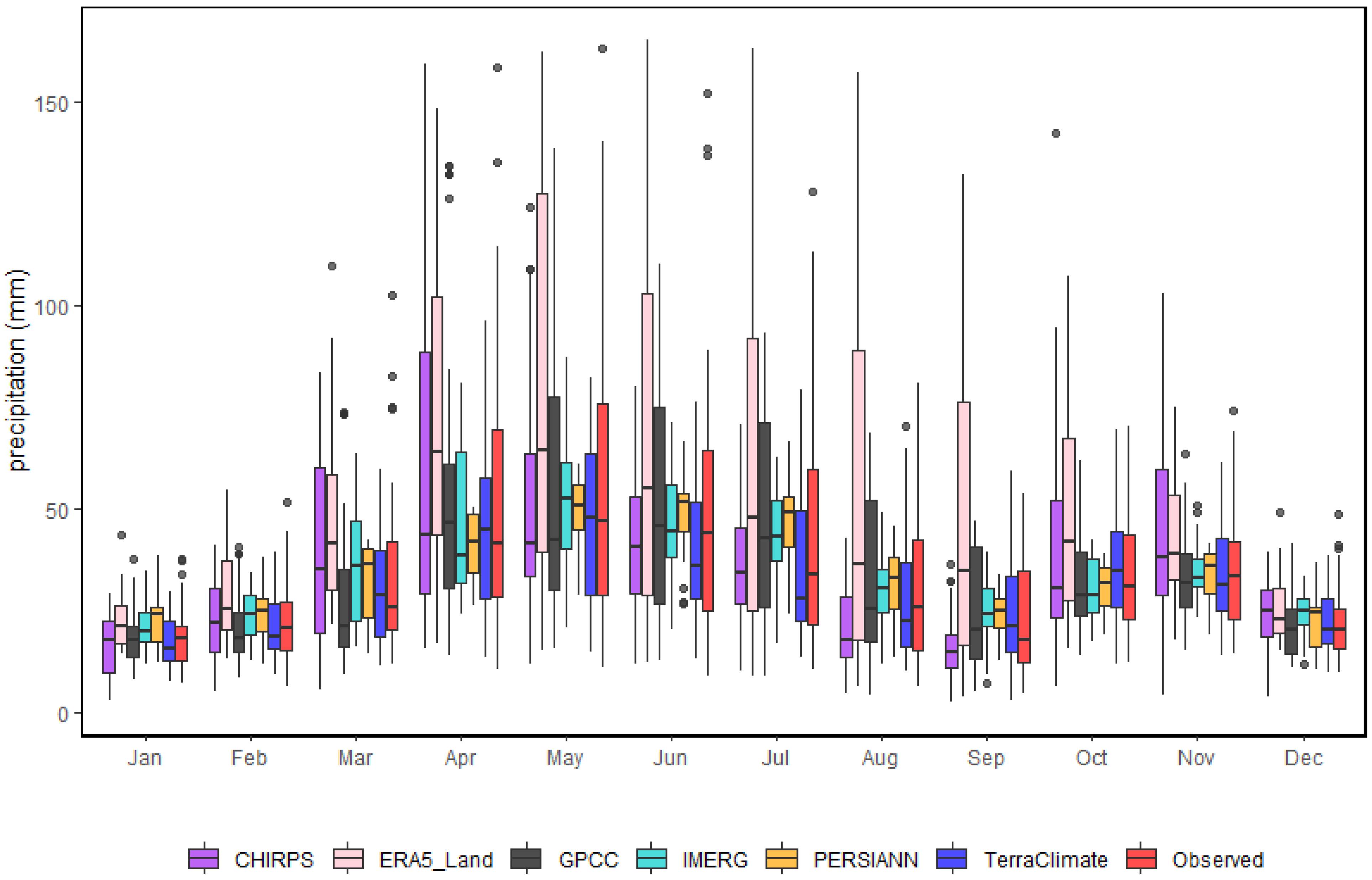

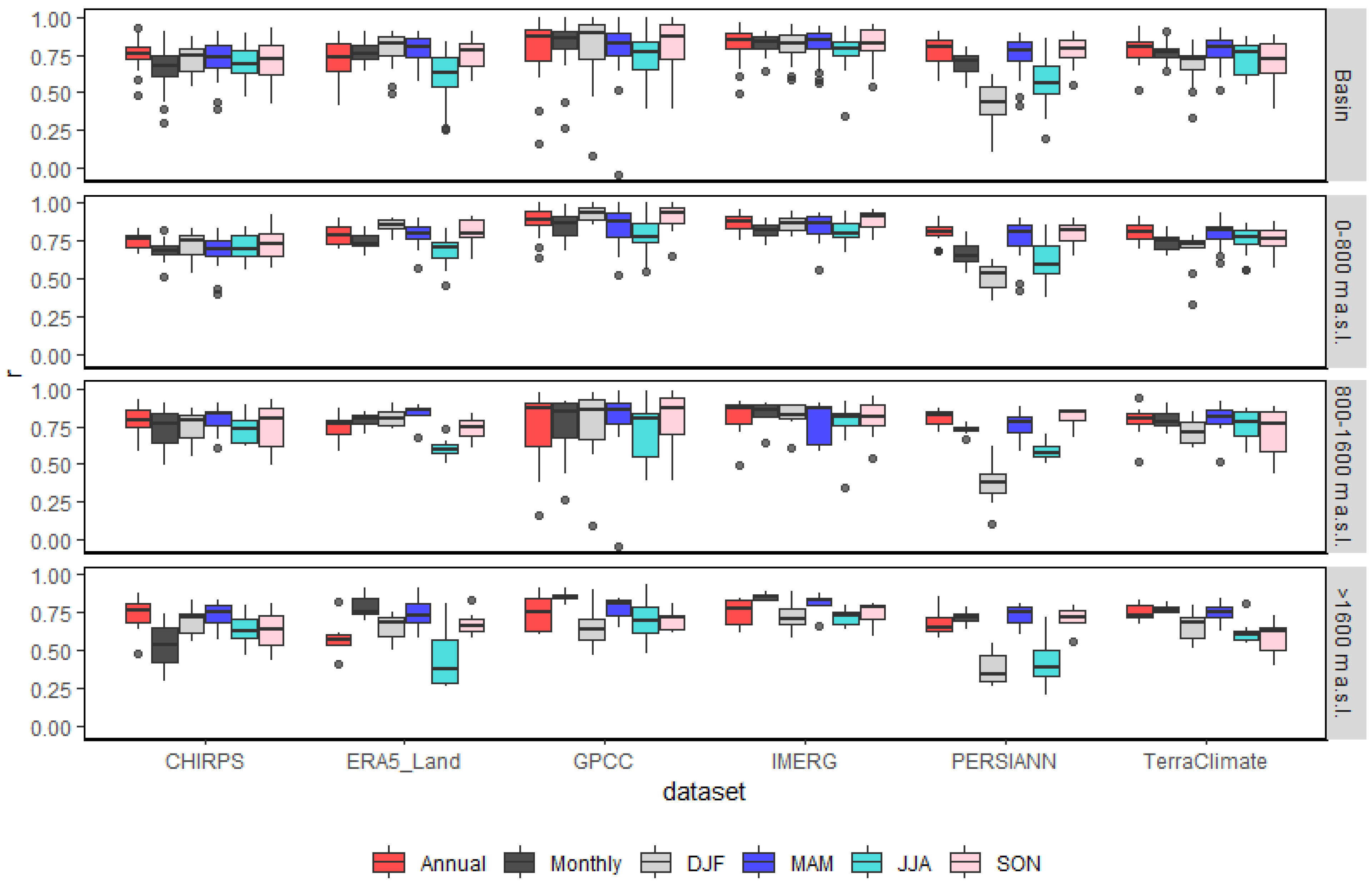
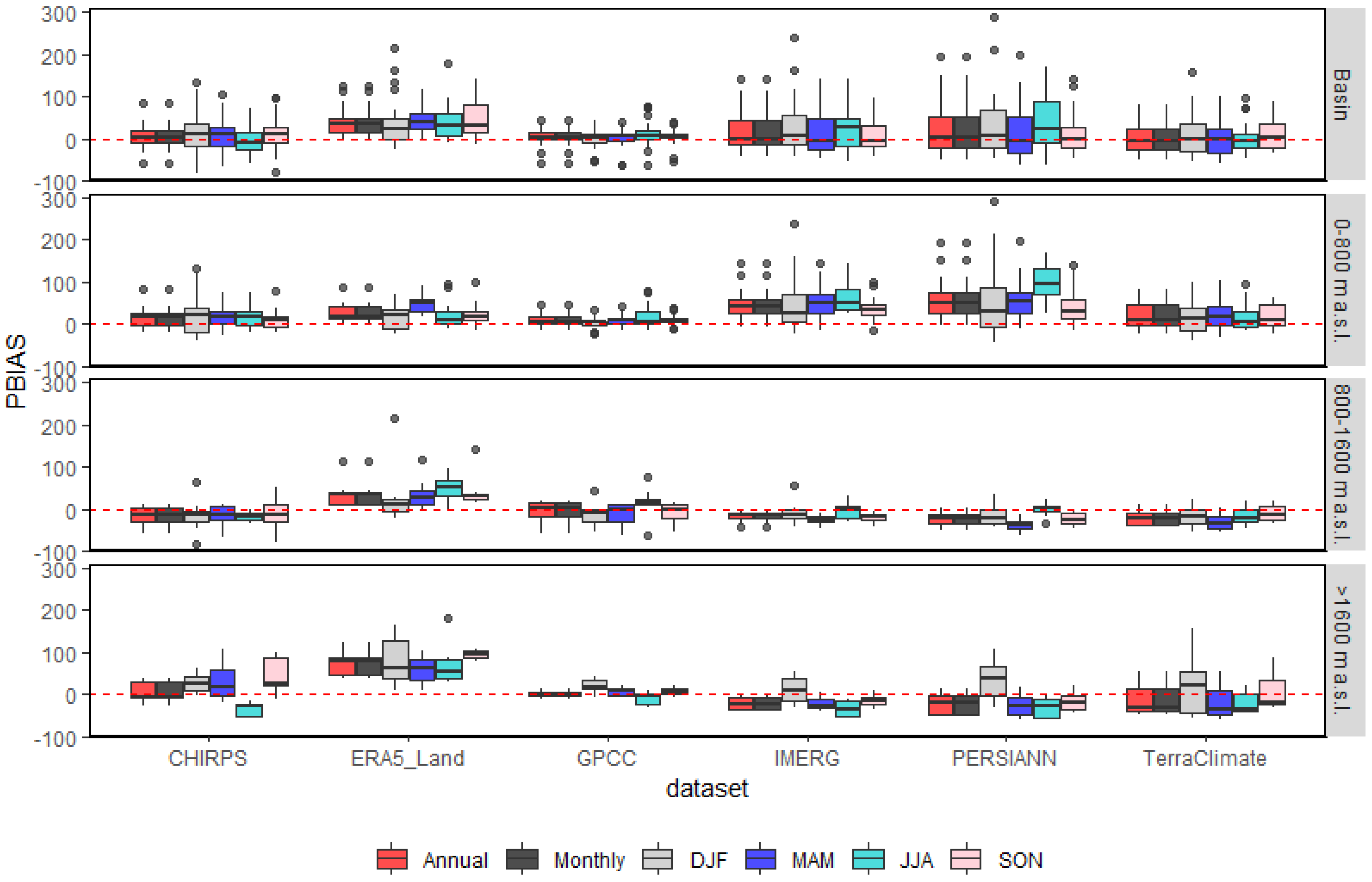
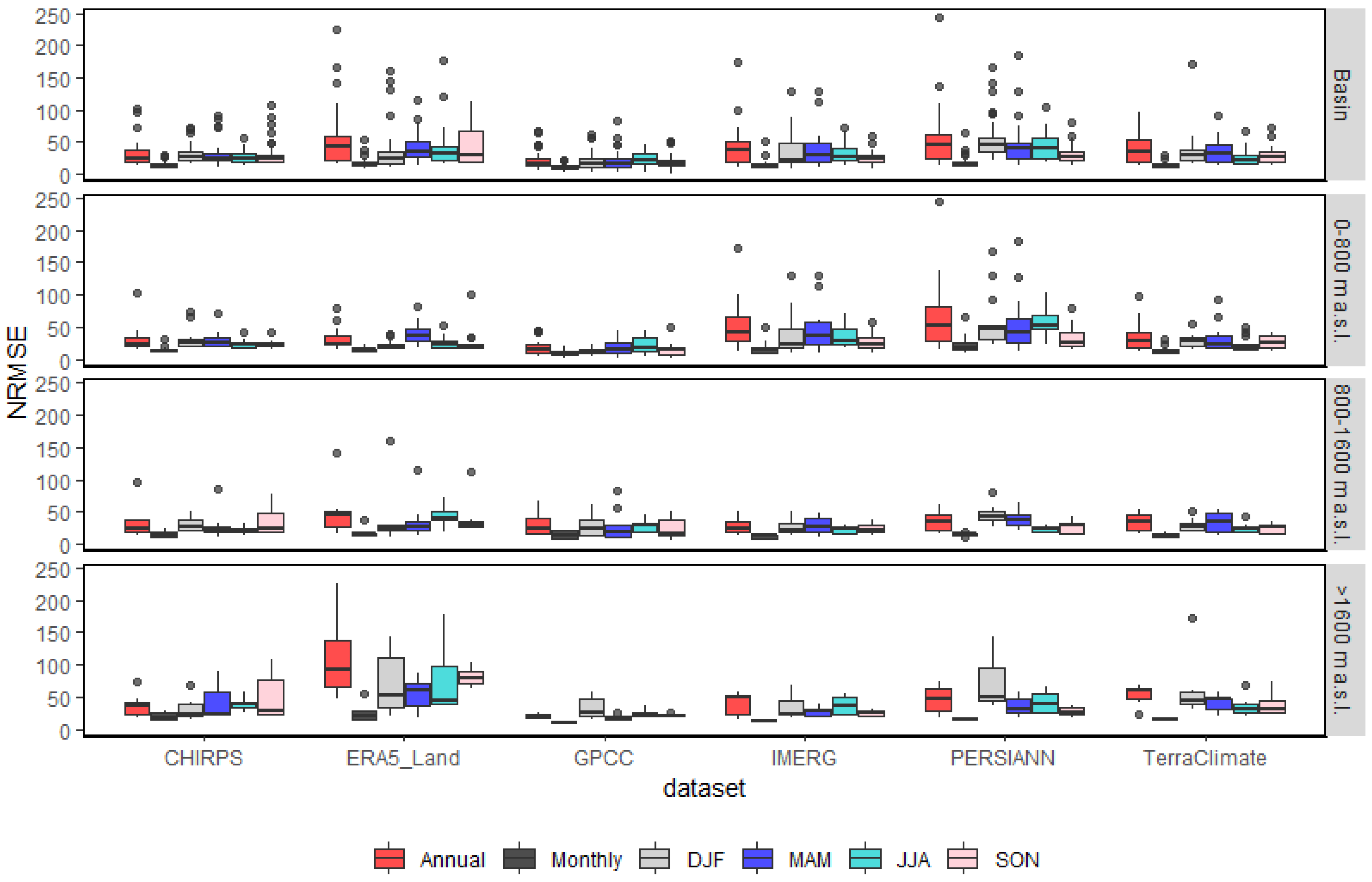


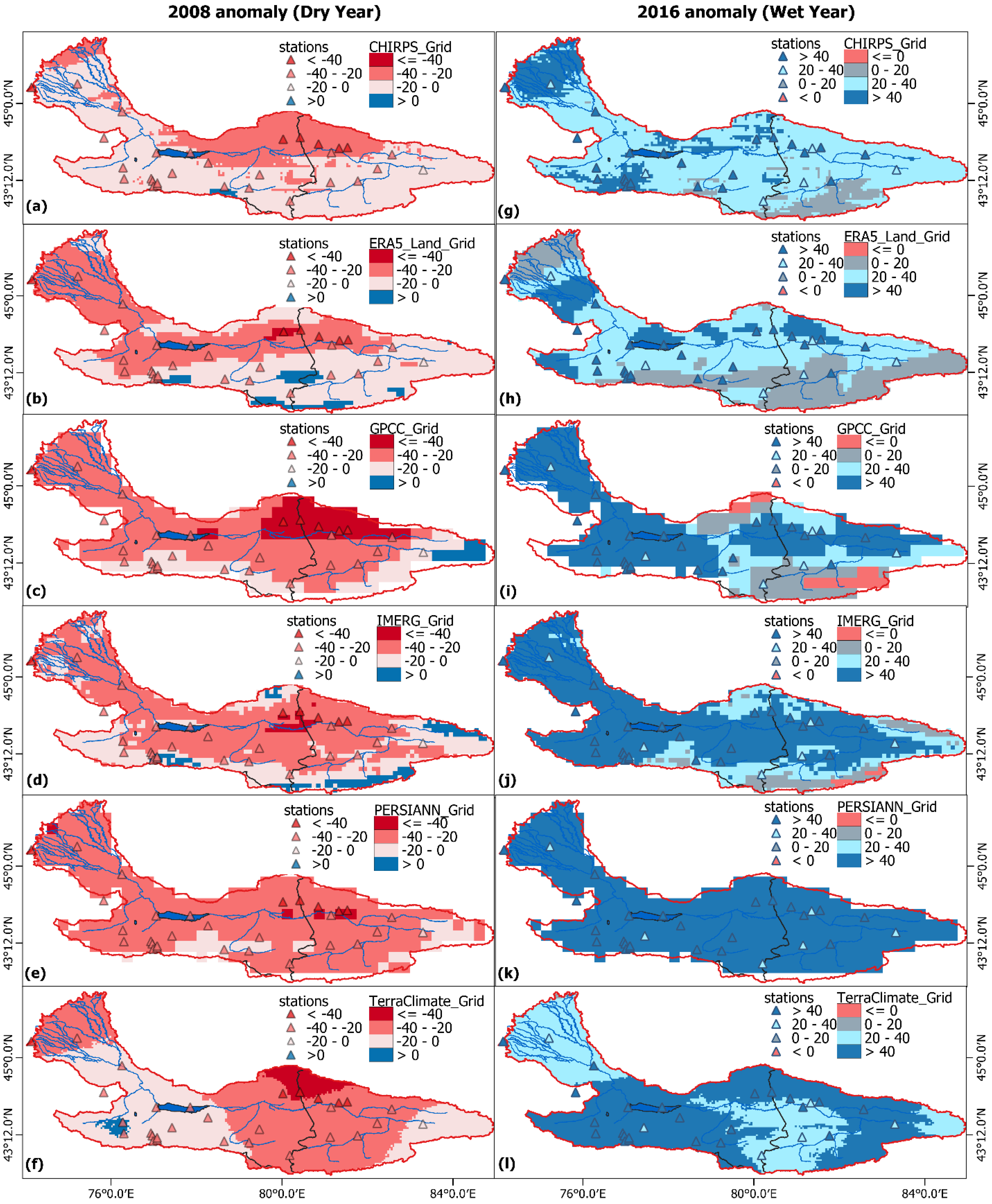
| Dataset | Description | Spatial Resolution | Temporal Resolution | Coverage | Data Availability | Citation |
|---|---|---|---|---|---|---|
| CHIRPS (Climate Hazards Group InfraRed Precipitation with Station data) | Merged satellite and station-based precipitation dataset | 0.05° (~5 km) | Daily, Monthly | Global (50° S–50° N) | 1981–present | [3] |
| ERA5 (ECMWF Reanalysis 5) _Land | Global reanalysis dataset from ECMWF, includes multiple atmospheric and land variables | 0.1° (~9 km) | Hourly, Monthly | Global | 1950–present | [7] |
| GPCC (Global Precipitation Climatology Centre) | Gauge-based global precipitation dataset | 0.25° to 2.5° | Monthly | Global | 1891–2020 | [10] |
| IMERG (Integrated Multi-satellite Retrievals for GPM) | Satellite-based precipitation estimates using GPM and TRMM data | 0.1° (~10 km) | 30-min, Daily, Monthly | Global (60° S–60° N) | 2000–present | [13] |
| PERSIANN (Precipitation Estimation from Remotely Sensed Information using Artificial Neural Networks) | Satellite-based precipitation estimates using infrared and microwave sensors | 0.25° (~25 km) | Daily, Monthly | Global (60° S–60° N) | 1983–present | [17] |
| TerraClimate | Climate and water balance dataset derived from multiple sources | 0.04° (~4 km) | Monthly | Global | 1958–present | [21] |
| Spatial | Temporal | Number of Observations | CHIRPS | ERA5_Land | GPCC | IMERG | PERSIANN | TerraClimate |
|---|---|---|---|---|---|---|---|---|
| Basin | Annual | 690 | 0.76 | 0.74 | 0.87 | 0.85 | 0.8 | 0.8 |
| Basin | Monthly | 8280 | 0.68 | 0.76 | 0.86 | 0.83 | 0.71 | 0.76 |
| Basin | DJF | 2070 | 0.74 | 0.82 | 0.89 | 0.82 | 0.45 | 0.72 |
| Basin | MAM | 2070 | 0.74 | 0.8 | 0.83 | 0.85 | 0.78 | 0.8 |
| Basin | JJA | 2070 | 0.69 | 0.63 | 0.77 | 0.79 | 0.56 | 0.77 |
| Basin | SON | 2070 | 0.72 | 0.78 | 0.87 | 0.82 | 0.79 | 0.72 |
| 0–800 m | Annual | 345 | 0.76 | 0.79 | 0.89 | 0.87 | 0.81 | 0.8 |
| 0–800 m | Monthly | 4140 | 0.68 | 0.73 | 0.86 | 0.82 | 0.64 | 0.75 |
| 0–800 m | DJF | 1035 | 0.75 | 0.85 | 0.93 | 0.86 | 0.54 | 0.72 |
| 0–800 m | MAM | 1035 | 0.69 | 0.8 | 0.88 | 0.86 | 0.81 | 0.82 |
| 0–800 m | JJA | 1035 | 0.69 | 0.71 | 0.78 | 0.8 | 0.59 | 0.77 |
| 0–800 m | SON | 1035 | 0.73 | 0.8 | 0.93 | 0.91 | 0.82 | 0.76 |
| 800–1600 m | Annual | 184 | 0.79 | 0.77 | 0.87 | 0.87 | 0.82 | 0.8 |
| 800–1600 m | Monthly | 2208 | 0.77 | 0.81 | 0.84 | 0.86 | 0.73 | 0.78 |
| 800–1600 m | DJF | 552 | 0.79 | 0.8 | 0.86 | 0.83 | 0.37 | 0.71 |
| 800–1600 m | MAM | 552 | 0.84 | 0.86 | 0.86 | 0.87 | 0.78 | 0.82 |
| 800–1600 m | JJA | 552 | 0.73 | 0.6 | 0.8 | 0.81 | 0.57 | 0.78 |
| 800–1600 m | SON | 552 | 0.8 | 0.75 | 0.86 | 0.81 | 0.85 | 0.77 |
| >1600 m | Annual | 161 | 0.77 | 0.57 | 0.75 | 0.78 | 0.65 | 0.72 |
| >1600 m | Monthly | 1932 | 0.53 | 0.75 | 0.85 | 0.85 | 0.71 | 0.76 |
| >1600 m | DJF | 483 | 0.72 | 0.68 | 0.63 | 0.7 | 0.34 | 0.68 |
| >1600 m | MAM | 483 | 0.74 | 0.72 | 0.8 | 0.83 | 0.75 | 0.75 |
| >1600 m | JJA | 483 | 0.63 | 0.37 | 0.7 | 0.73 | 0.38 | 0.6 |
| >1600 m | SON | 483 | 0.63 | 0.66 | 0.72 | 0.78 | 0.72 | 0.63 |
| Spatial | Temporal | Number of Observations | CHIRPS | ERA5_Land | GPCC | IMERG | PERSIANN | TerraClimate |
|---|---|---|---|---|---|---|---|---|
| Basin | Annual | 690 | 0.9 | 33.6 | 4.6 | −3.1 | 4.4 | −3.6 |
| Basin | Monthly | 8280 | 0.9 | 33.6 | 4.6 | −3.1 | 4.4 | −3.6 |
| Basin | DJF | 2070 | 9.1 | 22.6 | 2.4 | 8.8 | 8.3 | 0.2 |
| Basin | MAM | 2070 | 9.7 | 40.8 | 6.5 | −5.3 | −4.5 | −2.4 |
| Basin | JJA | 2070 | −10.1 | 31.8 | 6.9 | 26.2 | 24.6 | −6.3 |
| Basin | SON | 2070 | 10.5 | 30.6 | 4.3 | −3.4 | −1.4 | 3.5 |
| 0–800 m | Annual | 345 | 17.5 | 18.4 | 5.8 | 43.3 | 51.2 | 10.5 |
| 0–800 m | Monthly | 4140 | 17.5 | 18.4 | 5.8 | 43.3 | 51.2 | 10.5 |
| 0–800 m | DJF | 1035 | 19.3 | 20.4 | 4.4 | 25.3 | 29.6 | 13.3 |
| 0–800 m | MAM | 1035 | 18 | 51.5 | 8.1 | 48.2 | 54.4 | 17.8 |
| 0–800 m | JJA | 1035 | 18.7 | 8.3 | 5.8 | 49.4 | 92.7 | 3.7 |
| 0–800 m | SON | 1035 | 9.7 | 17 | 5.4 | 33.3 | 29.6 | 10.8 |
| 800–1600 m | Annual | 184 | −14.8 | 33.6 | 2.5 | −14.6 | −21.5 | −20.7 |
| 800–1600 m | Monthly | 2208 | −14.8 | 33.6 | 2.5 | −14.6 | −21.5 | −20.7 |
| 800–1600 m | DJF | 552 | −14.7 | 11.3 | −9 | −15 | −23 | −16.1 |
| 800–1600 m | MAM | 552 | −15.4 | 27.5 | −3.2 | −24.7 | −36.9 | −33.3 |
| 800–1600 m | JJA | 552 | −18.3 | 52.4 | 16.2 | −1.3 | 1.4 | −20.2 |
| 800–1600 m | SON | 552 | −13.8 | 31 | −1.4 | −17 | −26.2 | −13.5 |
| >1600 m | Annual | 161 | −6 | 76.4 | −0.3 | −25.9 | −21.9 | −33.3 |
| >1600 m | Monthly | 1932 | −6 | 76.4 | −0.3 | −25.9 | −21.9 | −33.3 |
| >1600 m | DJF | 483 | 23.4 | 63.4 | 18.1 | 10.1 | 38.2 | 20.5 |
| >1600 m | MAM | 483 | 17.9 | 61.3 | 7.5 | −28.6 | −29.8 | −34.8 |
| >1600 m | JJA | 483 | −29.9 | 53.7 | −1.9 | −36 | −28.3 | −36.1 |
| >1600 m | SON | 483 | 26.6 | 96.2 | 3.9 | −17.9 | −18.5 | −18.1 |
| Spatial | Temporal | Number of Observations | CHIRPS | ERA5_Land | GPCC | IMERG | PERSIANN | TerraClimate |
|---|---|---|---|---|---|---|---|---|
| Basin | Annual | 690 | 25.1 | 44.1 | 17.6 | 36.8 | 45.1 | 35.4 |
| Basin | Monthly | 8280 | 14.1 | 15.1 | 10 | 13.2 | 15.8 | 13.7 |
| Basin | DJF | 2070 | 25.9 | 23.2 | 16.4 | 23 | 46.5 | 30.6 |
| Basin | MAM | 2070 | 24.7 | 35.6 | 16.9 | 31.2 | 40.2 | 31.5 |
| Basin | JJA | 2070 | 24.2 | 28.5 | 16.7 | 24.4 | 27 | 27.6 |
| Basin | SON | 2070 | 24.4 | 33.6 | 21 | 25.9 | 40.5 | 21.5 |
| 0–800 m | Annual | 345 | 22.2 | 24.1 | 15.7 | 41 | 51.6 | 28.3 |
| 0–800 m | Monthly | 4140 | 12.8 | 13.9 | 9 | 15 | 18 | 12.9 |
| 0–800 m | DJF | 1035 | 26.8 | 19.2 | 10.8 | 22.5 | 46.9 | 28.1 |
| 0–800 m | MAM | 1035 | 25.7 | 35.6 | 15.5 | 36.4 | 42 | 23 |
| 0–800 m | JJA | 1035 | 22.7 | 21.8 | 16.8 | 28.9 | 53.7 | 17.7 |
| 0–800 m | SON | 1035 | 21.7 | 18.5 | 15 | 24.1 | 25 | 25.9 |
| 800–1600 m | Annual | 184 | 25.3 | 45.8 | 23.8 | 24.8 | 35.2 | 33.9 |
| 800–1600 m | Monthly | 2208 | 13.9 | 16 | 13.2 | 12.6 | 15.3 | 14.3 |
| 800–1600 m | DJF | 552 | 26.4 | 24.2 | 25.1 | 21 | 41.9 | 26 |
| 800–1600 m | MAM | 552 | 22 | 27.2 | 19.1 | 28.1 | 38.1 | 33.9 |
| 800–1600 m | JJA | 552 | 21.6 | 40.4 | 28.6 | 24.3 | 24.2 | 23.2 |
| 800–1600 m | SON | 552 | 25.3 | 29.4 | 16.3 | 23 | 29.3 | 27.4 |
| >1600 m | Annual | 161 | 36.5 | 91.2 | 18.4 | 50.6 | 48.1 | 59.2 |
| >1600 m | Monthly | 1932 | 16.7 | 20.2 | 9.7 | 12.8 | 15.6 | 14.9 |
| >1600 m | DJF | 483 | 24 | 59.1 | 18.3 | 28.2 | 30.3 | 47 |
| >1600 m | MAM | 483 | 23.4 | 53 | 25.2 | 23.9 | 48.4 | 44.1 |
| >1600 m | JJA | 483 | 37.9 | 44.2 | 22.1 | 35.1 | 38.8 | 31.3 |
| >1600 m | SON | 483 | 29.1 | 78.6 | 20.1 | 24.6 | 26.7 | 30.1 |
Disclaimer/Publisher’s Note: The statements, opinions and data contained in all publications are solely those of the individual author(s) and contributor(s) and not of MDPI and/or the editor(s). MDPI and/or the editor(s) disclaim responsibility for any injury to people or property resulting from any ideas, methods, instructions or products referred to in the content. |
© 2025 by the authors. Licensee MDPI, Basel, Switzerland. This article is an open access article distributed under the terms and conditions of the Creative Commons Attribution (CC BY) license (https://creativecommons.org/licenses/by/4.0/).
Share and Cite
Duisebek, B.; Senay, G.B.; Ojima, D.S.; Zhang, T.; Sagin, J.; Wang, X. Evaluating the Performance of Multiple Precipitation Datasets over the Transboundary Ili River Basin Between China and Kazakhstan. Sustainability 2025, 17, 7418. https://doi.org/10.3390/su17167418
Duisebek B, Senay GB, Ojima DS, Zhang T, Sagin J, Wang X. Evaluating the Performance of Multiple Precipitation Datasets over the Transboundary Ili River Basin Between China and Kazakhstan. Sustainability. 2025; 17(16):7418. https://doi.org/10.3390/su17167418
Chicago/Turabian StyleDuisebek, Baktybek, Gabriel B. Senay, Dennis S. Ojima, Tibin Zhang, Janay Sagin, and Xuejia Wang. 2025. "Evaluating the Performance of Multiple Precipitation Datasets over the Transboundary Ili River Basin Between China and Kazakhstan" Sustainability 17, no. 16: 7418. https://doi.org/10.3390/su17167418
APA StyleDuisebek, B., Senay, G. B., Ojima, D. S., Zhang, T., Sagin, J., & Wang, X. (2025). Evaluating the Performance of Multiple Precipitation Datasets over the Transboundary Ili River Basin Between China and Kazakhstan. Sustainability, 17(16), 7418. https://doi.org/10.3390/su17167418







